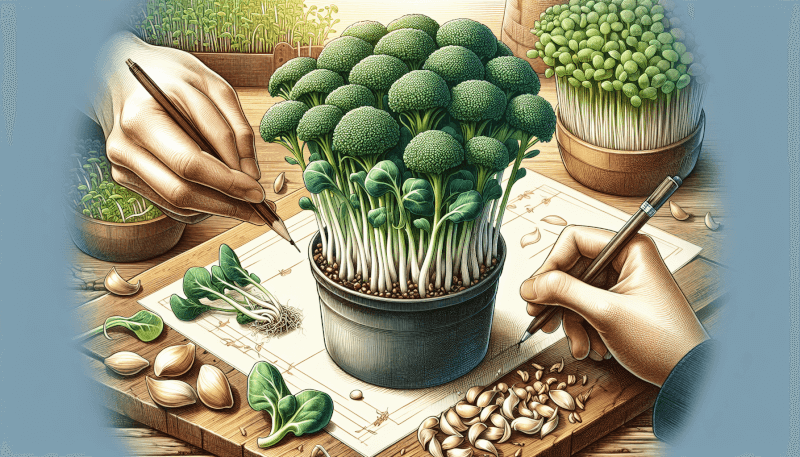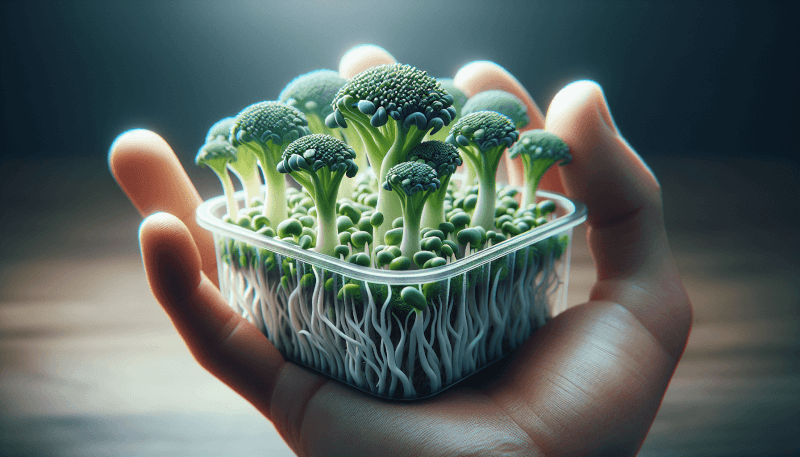👋 Click the mic button to talk to Alfred, the Todd's Seeds Gardening/Sprouting Expert – Feel free to ask him anything!
Ask Virtual Todd Anything - Click the Mic
If you’re a fan of broccoli and love adding a healthy kick to your meals, you’ll be thrilled to learn how to grow broccoli sprouts at home! In this article, we’ll guide you through the simple and satisfying process of growing these nutrient-packed sprouts. With just a few easy steps, you’ll enjoy the delicious taste and numerous health benefits of fresh broccoli sprouts, all while cultivating your green thumb. So grab your gardening gloves, roll up your sleeves, and embark on this exciting journey of growing broccoli sprouts at home!
How to Grow Broccoli Sprouts at Home – Choosing the Right Seeds
Research Different Varieties
When growing sprouts at home, the first step is to choose the right seeds. Researching different varieties of seeds will give you a better understanding of the specific requirements and growing conditions for each type. Consider factors such as flavor, texture, and nutritional value to find the variety that suits your preferences.
Purchase High-Quality Seeds
After researching different varieties, it’s important to purchase high-quality seeds. Look for reputable seed suppliers who offer seeds that have been tested for viability and are free from contaminants. Buying seeds from a trusted source will greatly increase your chances of successful sprout germination and growth.
Consider Organic Options
If you prefer to grow your sprouts organically, consider purchasing organic seeds. Organic seeds are grown without the use of synthetic pesticides, herbicides, or fungicides. Choosing organic options ensures that you’re consuming sprouts that are free from harmful chemicals and that have been produced in an environmentally friendly manner.
Preparing the Equipment
Gather the Necessary Supplies
Before you begin the sprouting process, gather all the necessary supplies. These include sprouting trays or jars, fine mesh or cheesecloth, scissors, and water. Having everything ready will make the process smoother and more efficient.
Clean and Sterilize Equipment
To avoid potential contamination, cleaning and sterilizing all the equipment before use is crucial. Wash the sprouting trays or jars with warm, soapy water, thoroughly rinsing them afterward. Additionally, sterilize the equipment by soaking it in a solution of one part bleach to ten parts water for about 15 minutes. Rinse thoroughly with water after sterilization.
Set Up a Sprouting Area
Create a designated sprouting area where you will grow your sprouts. Find a clean, well-lit spot in your home that receives indirect sunlight. Avoid placing the sprouts in direct sunlight, which could cause overheating and hinder growth. Set up your equipment and ensure that it is positioned for optimal growth and ease of maintenance.

Soaking and Preparing the Seeds
Measure the Desired Amount of Seeds
Once your equipment is ready, measure out the desired amount of seeds for sprouting. Refer to the seed supplier’s instructions or general guidelines for the correct amount, as it may vary depending on the seed type and the sprouting tray or jar size. Generally, you use one to two tablespoons of broccoli seeds.
Rinse the Seeds
Before soaking the seeds, it’s important to rinse them thoroughly. Rinse them under cool running water to remove any dirt or debris. Rinsing also helps hydrate the seeds before they are soaked, enhancing germination.
Soak the Seeds in Water
After rinsing, place the seeds in a glass jar or sprouting tray and cover them with cool water. Allow the seeds to soak for the recommended amount of time, typically 8-12 hours. Soaking the seeds initiates germination and softens the outer shell, making it easier for the sprouts to emerge.
Germination Process
Choose the Germination Method
There are several germination methods to choose from when growing sprouts. The most common methods include using a sprouting tray with soil or a jar with a mesh or cheesecloth lid. Research the different methods and select the one that best suits your preferences and available resources.
Drain the Soaked Seeds
Once the seeds have finished soaking, drain the water from the sprouting tray or jar. Ensure that any excess water is thoroughly drained to prevent the seeds from becoming waterlogged, which can lead to mold or rot.
Sprout the Seeds
Place the drained seeds in the sprouting tray or jar and follow the specific instructions for the chosen germination method. Generally, this involves rinsing the seeds with water and draining any excess water every 8-12 hours. Continue this process until the sprouts reach the desired length or until the seed shells have fallen off.

Maintaining the Sprouts
Provide Adequate Moisture
To maintain healthy sprouts, it’s crucial to provide them with adequate moisture. Ensure that the sprouting tray or jar is always slightly moist but not waterlogged. Monitor the moisture level regularly and adjust as necessary to prevent the sprouts from drying out or becoming too wet.
Ensure Sufficient Air Circulation
Good air circulation is important for the sprouts to thrive. Ensure that the sprouting tray or jar has proper ventilation to prevent the build-up of excess moisture, which can lead to mold or fungal growth. If using a jar, periodically remove the lid to allow fresh air to circulate.
Monitor Temperature
Keep an eye on the temperature of the sprouting area. Most sprouts prefer a temperature range between 65-75°F (18-24°C). Avoid exposing the sprouts to extreme temperature fluctuations or direct sunlight, as this can affect their growth and quality.
Watering and Rinsing
Water the Sprouts Regularly
Regular and consistent watering is crucial for the growth of healthy sprouts. Depending on the germination method and specific instructions, water the sprouts every 8-12 hours or as directed. Use clean, filtered water to ensure the best quality sprouts.
Avoid Overwatering
While it’s important to keep the sprouts moist, be cautious not to overwater them. Overwatering can lead to the growth of mold and other harmful organisms. Monitor the moisture level carefully and make adjustments as needed.
Rinse the Sprouts to Prevent Mold
In addition to watering, rinsing the sprouts regularly is important to prevent the growth of mold. Rinse the sprouts gently with clean water to remove any debris or excess moisture. This will help maintain the cleanliness and freshness of the sprouts throughout the growing process.
Harvesting
Determine Optimal Harvest Time
Knowing when to harvest the sprouts is crucial for achieving the best flavor and nutritional value. As a general rule, harvest the sprouts when they have reached the desired length specified for the particular seed variety. This is typically around 3-5 inches (8-13 cm) in length.
Cut the Sprouts with Clean Scissors
When it’s time to harvest, use clean scissors to cut the sprouts just above the root or seed hull level. Be gentle and avoid damaging the delicate sprouts. Cutting them at the root level will leave the roots intact for easier storage and handling.
Thoroughly Rinse the Harvested Sprouts
After harvesting, thoroughly rinse the sprouts to remove any debris, seed hulls, or loose roots. This will ensure that the sprouts are clean and ready to be consumed or stored.
Storing and Using Sprouts
Dry the Sprouts
Before storing the sprouts, it’s important to dry them thoroughly. Spread the sprouts out on a clean towel or paper towel, allowing them to air dry for a few hours. This will help remove excess moisture and prevent them from becoming soggy during storage.
Choose Appropriate Storage Containers
Select appropriate storage containers for your sprouts. Consider using airtight containers such as glass jars or plastic containers with a tight-fitting lid. Choose containers that are clean, dry, and have sufficient space to accommodate the sprouts.
Store the Sprouts in the Refrigerator
For optimal freshness and to extend the shelf life of the sprouts, store them in the refrigerator. Place the sprouts in the designated storage containers and keep them in the vegetable crisper or the coldest part of the refrigerator. Stored properly, sprouts can typically be kept fresh for up to a week.
Troubleshooting Common Issues
Prevent and Treat Mold
Mold is a common issue when growing sprouts, but there are measures you can take to prevent and treat it. Ensure that the sprouting area is clean and well-ventilated, and avoid overwatering the sprouts. If mold does develop, remove any affected sprouts immediately and increase ventilation to prevent further growth.
Combat Pests
Pests such as fruit flies can be a nuisance when growing sprouts. To combat them, maintain a clean and hygienic sprouting area. Remove any decaying organic matter and regularly clean the equipment. If necessary, use natural pest control methods such as vinegar traps to deter pests.
Address Yellowing or Wilting
Yellowing or wilting of sprouts can indicate a lack of moisture or insufficient air circulation. Ensure that the sprouts are receiving adequate water and adjust the ventilation if needed. If the issue persists, it may be necessary to review the germination process and make any necessary adjustments.
Experimenting and Enjoying
Try Growing Different Seeds
Once you have mastered growing broccoli sprouts, don’t hesitate to experiment with different types of seeds. Explore the world of sprouting by trying seeds such as alfalfa, radish, lentils, or sunflower seeds. Each seed will offer its own unique flavor and nutritional benefits, allowing you to enjoy a variety of sprouts in your dishes.
Incorporate Sprouts into Various Dishes
Sprouts are incredibly versatile and can be incorporated into a wide range of dishes. Add them to salads, sandwiches, wraps, stir-fries, or even smoothies for a fresh and nutritious boost. Their crunchy texture and vibrant flavor make sprouts a wonderful addition to your culinary creations.
Share and Enjoy the Nutritious Sprouts
Don’t forget to share your homegrown sprouts with friends and family. Spread the joy of growing and enjoying nutritious sprouts by giving them as gifts or sharing recipes that highlight their unique flavors. Growing sprouts at home is a rewarding experience and a way to promote healthy eating and sustainable living. Enjoy the fruits (or sprouts) of your labor!